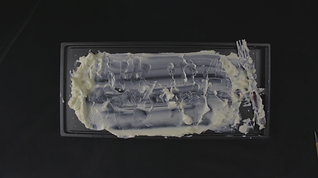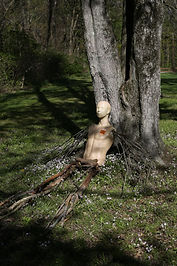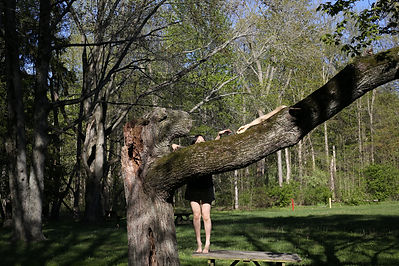
"If wandering is the liberation from every given point in space,
and thus the conceptional opposite to fixation at such a point,
the sociological form of the "stranger" presents the unity,
as it were, of these two characteristics."
Georg Simmel
An Uncontrolled Expression: A Butter Keyboard, 2020
Communication technology allows us to connect with the other side of the earth, while words and emotions become data, flickering on the smooth screen. My fingers, as a tool used to write words, as a tool now used for typing, long for an out-of-control expression.
I made a butter keyboard without letters. In a random scene, I engraved letters on the keyboard, and the positions of the engraved letters are random. In the process of typing, I keep hesitating, because the positions of the letters are chaotic and the material butter makes letters hard to see. Every time I type one letter, I need to look for a long time. At the same time, because the keyboard is butter, my finger temperature will melt it, the letters will gradually become blurred, and I have to re-engrave it.
This typing process is tedious, repetitive, and even sometimes annoying. The keyboard finally melted, and the line of words that took me half an hour to type disappeared at the same time.




Three Big Cookies and One Small: The Weight of Gene Differences, 2020
I have been asked by annoying relatives since I was very little: "Do you prefer your stepmother more or birth mother?"
I can not remember my answer at that time. Now I want to use art practice to answer this question. I made molds of my family members’ hands, my birth mother (Zeli), my birth father(Feng), my stepmother (Xiumei), and my half-sister(Jing). Then I put my hand in the molds, filling the gaps with a mix of flour and sugar, and measuring the weight of the mix that filled the gap. The more mix I use, the greater the difference in hand shape. Vaguely pointed out the greater gene difference.
Finally, I baked these four piles of sugar and flour into biscuits. I also attached the words that impressed me the most.





A Pizza, Marshmallows, and Pretzels Sticks, 2020
An anthologist, Biao Xiang made a very enlightening point, "Disappearing neighborhood", in a show. “People give too much trust to technology companies and algorithms, but people cannot engage with this highly centralized system: you cannot participate in the algorithmic decision, resulting in a sense of loss and powerless. People's trust and relationship with the surrounding environment have been weakened.
How can I reconstruct the physical perception of my neighborhood and build a tangible relationship with it? When I was a child, in natural science class, the teacher took us to smell, touch, and find the laws of the natural world. “People used to describe time with a physical phenomenon such as a stick of incense time’. “
I ordered an Aloha BBQ pizza at the pizzeria downstairs and set off from there. Then I just went north very casually and measured the temperature of the pizza about every five minutes until the temperature of the pizza drops to the outdoor temperature.
After this process, I got the route I walked, the distance, the time, and the temperature change of the pizza.
Then I built a mathematical model with these data.
Finally, I visualized the mathematical model with marshmallows and Pretzels Sticks. This mathematical model is inaccurate and has no scientific functions, but it is related to me. Its process and results are describing my relationship with the neighborhood at that particular time. By establishing a private, non-universal algorithm, I try to have more imagination about the algorithm and physical space.
Human ⇄ Ghost: Food Delivery Drivers As Locals, Strangers, and Wanderers, 2021
Earlier industrial transformation and the epidemic have made more and more people become gig workers.
I interviewed some food delivery drivers from the Ubereats, Their differences in race and immigration status lead to their polarized feelings about the job. For local people of Chicago who work as Ubereats drivers, they consider this job as “*ghost work”, without social interaction: working all day and contacting real people for less than 5 minutes. The lack of social regularity and community makes people feel like a machine or a small parameter that keeps beating in the algorithm.
The new Chinese immigrants are “ *strangers”, living in language and cultural barriers. Such ghost work, a job not required of speaking English, provide them with shelter, becoming a strategy of living in the United States but away from American culture. On some non-algorithm-driven Chinese food delivery platforms, interesting acquaintance societies have been constructed. Finally, I met a new immigrant from Bulgaria, he is now an Ubereats driver in London. He considers this as a job geographically unconstrained, allowing him to completely become a liquid individual, floating around the world. He recently decided to live in an RV and work as a delivery worker in different places, so as to travel around the UK and the world.
I hope that this work can provide multiple opinions of the gig platform from a global perspective, and I also ask, what kind of new possibilities now we have with the ghost work characterized by high mobility?
*Ghost work, from Ghost Work, Book by Mary L. Gray
*Stranger, from The Stranger, Georg Simmel
Fluid Asking Series - When Can I Swim into the Sky




Fluid Asking Series - Who is X




Fluid Asking Series - A Restless Dream of A Mannequin
Connection / Disconnection - fluid interactions; asking: Who I am, 2021
Emerging technologies allow capital to flow at ever greater speed with efficiencies that satisfy the capitalist system’s desire for constant innovation, feedback loops, and profit. Labor is constantly being purchased, exploited, and discarded. Time and labor coexist within a framework of temporality and redundancy. Labor is purchased and consumed along with the products of labor and just as easily discarded. Only the truly skillful escape the tentacles of this cannibalistic machine.
If caught in the tentacles of this system we must construct and reconstruct ourselves at every moment, question ourselves, analyze ourselves, criticize ourselves, transform ourselves, abandon our existing identity and acquire a completely different identity.
Uncertain, ignorant, powerless, silent: The ordinary and every day at the mercy of flows and networks outside of any real agency or enabling structure.
Today, in a drastic turnaround, I met X.
X is a Mannequin. He has worked for Gap for more than 10 years, but because of the rise of e-commerce and the covid-19 pandemic, he was abandoned and sold by Gap for $10. X was born of, for, and above all to flatter capitalist ideals and is now rejected by the very system he served.
I took him home. Together with several artists, we created a second life of possibilities for X outside the system and yet, perhaps part of another system. Nevertheless, he lives on his own outside of capitalism. In the interaction between X and these artists, X gained his own memory; while at the same time becoming a mirror – reflecting the fragility and anxiety of these artists and ordinary people alike.
KE ZHANG: The way you present your work is very diverse. Would you like to tell us more about how you choose between different forms of artistic presentation?
LISHA CHEN: The way I choose to display my art is what I call the “performing object”. I have a background in design objects; however, what I want to show via my artworks is the interaction between the objects’ background and my comprehension of the objects. It’s like a scenario of logic behind a project. Although the way I choose to display my artworks is a very important part of my piece, the most important part is the concept behind each project.
KE ZHANG: Some of your projects, like the Weight Of Gene Difference, is a project about your family. As a friend of yours, I know that you come from a reconstructed family. Are your special memories and experience with family taking an important role in enlightening your art-making process?
LISHA CHEN: Thank you for the question! As an artist, I feel that one of the most important elements of the communication between artists and their audience is earning “trust” from the audience. Especially for performance artists, being able to make their performance persuasive is critical to the feeling of the audience. For myself, I created artworks based on my own experience and memories because I want the artworks to show honesty and realness to my audience, and I want them to trust me. I believe this is how I make my work reliable. In addition, I do have a passion for creating my own family and I am willing to express my self-reflection toward my family.
However, even though I admit that my own experience and memories are important to my creating process, I want my audience to see the universality inside. I believe every personal experience is a reflection of the change and revolution of the current society. I hope that my works speak for more people as well.



An Uncontrolled Expression: A Butter Keyboard, 2020
KE ZHANG: Material Choice, food materials. The next question is about your choice of using food during the making process. Your project, The Butter Keyboard, A Pizza, Marshmallows and Pretzels Sticks, and The Weight of Gene Differences all use food-making materials. Is this a decision on purpose?
LISHA CHEN: Good question! This actually has a lot to do with the time! At the beginning of 2019, I started making these projects, which is also the start point of Covis-19. During this period of time, I‘m in a limited situation because I always stayed at home. This is the main reason why I utilized a lot of food-making materials-because I can only get access to these materials at home.
On the other hand, during this period of time, I was trying to reconstruct the relationship between the surroundings and myself. Under these circumstances, food is an effective tool for me to have to interact with the surrounding environment.
KE ZHANG: Do you want to tell us more about the utilization of media and your comprehension of the difference between intuitive impulse and well-thoughtful actions?
LISHA CHEN: I am always afraid of well-thoughtful actions and familiarity with the media. This is because I am worried that my project will lack intuitive impulse after me being familiar with the method. For the project, The Butter Keyboard, I was looking for a feeling of “out of control”. For the keyboard I made with butter, it was melting while I type with it. As time goes by, it melts more and more, but I must face the feeling of “out of control” and I must try to type what I want to say with the melting keyboard.
This reminds me of the early stage of the development of online chatting. In the beginning, we are not familiar with typing and the keyboard, so every word and sentence we tyle has meaning. However, much more meaningless expressions appear when we chat online. I hope this project can bring the audience back to the time when every word we type has meaning, and to experience the efforts we need to put in when we express ourselves.



Connection / Disconnection - fluid interactions; asking: Who I am, 2021
KE ZHANG: If we look at your artworks based on the timeline, we can obviously see yourself changing your opinion or attitude of Capitalism. Is that true?
LISHA CHEN: Thank you for the question. Yes absolutely. As time went by, I realized that the art-making process does not only influence the audience but also influences the artists themselves as well. Self-criticism is one of the most important parts of the process. During the making process, besides proposing the problem, my professor always asks me: “What’s next?”
In my research process, I divided it into “First-hand research” and “Second-hand resources”. For “First-hand research”, I mean what I myself see, hear, and feel during the process. For “Second-hand resources”, I mean existing references.
At the beginning of my art career, I always had a negative idea about “Capitalism” because it dehumanized people from their unique characteristics. However, during the research process of the project - the “Human-Ghost” documentary, I changed my opinion about “Capitalism” a lot.
During the research process, besides what I called “Second-hand resources”, I interact with the people who work as food delivery drivers in foreign countries for half a year. The interactions include sending food together with them, interviewing other delivery men, and now I am working in this company as a graphic designer in order to know more about this job.
My opinion changed from critique to inclusiveness. After talking and interacting more with the food delivery drivers, I consider this social issue (like Capitalism) with an open mind. I even tried to challenge authority. This is because I found what I called the “dehumanization” in “Capitalism” in this career, the food delivery drivers, is not necessarily one hundred percent bad. As a food delivery driver, you don’t even need to be able to speak a new language in order to live in a new country because you don’t need to talk with customers as Uber drivers; the only thing the food delivery drivers need to do is sending food to the building and leave it at the front desk. This job provided those new immigrants including those from China, even Bulgaria with a precious opportunity to stay in the country.
I also hope my work can bring audience views of different aspects about one issue. Life is much more complicated than what we read from books or what we learn from school. Social issues are more like a web instead of a linear inference with a reason and a result. For one who works as a food delivery driver, the reasoning for choosing this job might not only be because of immigration, it might also contain poverty and others.
I believe that as an artist, we need to embrace and feel the “complicated web” of life and society deeply, instead of simply criticizing one situation written in a book.
KE ZHANG: You graduated from SAIC last semester. Do you encounter any difficulties when you make your pass from school to society? What’s the result or the solution you made?
LISHA CHEN: I have encountered two main difficulties. The first one is that my life experience is very limited. The second one is that I am always afraid my artworks are not showing the complexity of real life. And the result is that I become more inclusive and I kind of start having some “Rebellious spirit”.
During the Covid-19, I meet X (Connection / Disconnection - fluid interactions; asking: Who am I), a wooden model, in a closed GAP store. From my point of view, he is not only an object. He used to be a worker in this clothing store before, though he lost his job now. This situation made me realize that at current times when the society is facing any difficulties, the “Capital” can withdraw quickly, but the frontier labor will be forced to face the result (losing jobs).
With the development of technology, one’s identity changes very fast. Everyone in society needs to reconstruct their identity very fast. For myself, I was a kid when I was in my family; I became a worker when I worked for the food delivery company; I was a foreigner when I studied here, and I identified as a woman in society. For X, he worked as a model in the clothing store; but he is an unemployed person now. While living with me, X had more and more identity to himself.
INTERVIEWER: KE ZHANG
CURATOR: KE ZHANG, WANTONG YAO
EDITOR: WANTONG YAO, KE ZHANG
GRAPHIC DESIGNER: YUXUAN WEI

Lisha Chen is an artist focusing on digital sociology and biological relationships. Her art practices are mostly conceptual art pieces with interdisciplinary approaches from sculpture, performance, virtual reality, fashion, comics, etc. Her recent practices tended to combine objects with performance, taking the objects to their next level of logical activation. She believes art can help people see the new possibilities of life in the alienated contemporary. Lisha obtained an undergraduate degree in industrial design in China, currently a graduate student in designed objects at the School of the Art Institute of Chicago.





%20(1).jpg)